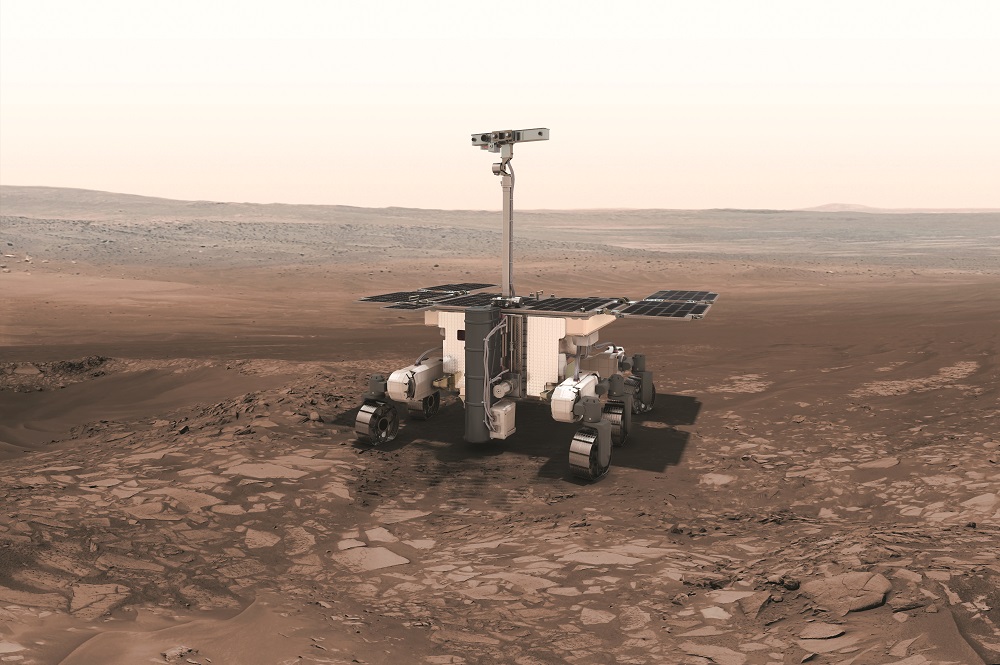COLORADO SPRINGS — The European Space Agency awarded a contract to a consortium of companies to resume work on a Mars rover mission that was derailed two years ago by geopolitics.
ESA announced April 9 it awarded a contract worth 522 million euros ($567 million) to a team led by Thales Alenia Space to restart work on the ExoMars Rosalind Franklin mission. That mission will deliver to the surface of Mars the Rosalind Franklin rover, equipped with a drill that will go up to two meters into the surface, collecting material to analyze for evidence of past or present life.
ExoMars was scheduled to launch in September 2022 on a Russian Proton rocket, part of a partnership between ESA and Roscosmos that also included Russian development of a landing platform for the rover. However, ESA suspended cooperation on the mission weeks after Russia’s invasion of Ukraine in February 2022 and put the completed rover in storage.
The new contract covers work to replace some of the contributions Russia provided. Thales Alenia Space, the prime contractor, will lead the design of a new landing platform to replace the Russian design, and will handle assembly, integration and testing work. Airbus Defence and Space, which built the rover, will provide mechanical, thermal and propulsion systems for the landing platform. ArianeGroup will be responsible for the landing module’s heat shield and OHB a carrier module.
“There is a complementary difference in technologies and experience that each of the major players in the consortium have,” said Massimo Comparini, deputy chief executive and senior vice president for observation, exploration and navigation at Thales Alenia Space, said in a briefing about the new contract at the 39th Space Symposium.
Besides getting ExoMars back on track, the contract will help Europe develop key technologies in entry, descent and landing, or EDL. “The key aspect is that we develop new capabilities in Europe, industrial capabilities,” said Daniel Neuenschwander, ESA director of human and robotic exploration, at the briefing. “EDL is a key topic.”
The new lander will not require any major modifications to the rover itself, he said. Thales Alenia Space noted in a statement that its work on the contract will include a “full audit and tests” of the rover and other mission hardware, as well as the installation of a new infrared spectrometer instrument on the rover.
ExoMars will also incorporate contributions from NASA under a partnership between NASA and ESA announced after Russia was removed from the mission. NASA will provide aerobraking engines and radioisotope heating units (RHUs), small devices that use the heat produced by the decay of plutonium to keep the spacecraft warm.
NASA will also provide a launch of the mission, currently scheduled for the fourth quarter of 2028. Neuenschwander said NASA is currently procuring a launch vehicle for ExoMars but has not selected one yet. “There are natural candidates that you can imagine that are currently operational launchers currently going from U.S. soil” that could be used for ExoMars, he said.
Comparini said there was no one specific factor on the critical path to that late 2028 launch date. “It’s more the complexity of what must be refurbished and adapted for the mission,” he said.
“We are now facing the classical challenges we have in these types of missions,” Neuenschwander added, calling the new contract a “major stabilization” of the program. “Now, a lot of work remains to be done, but we are back on track in a nominal, typical space program.”
Related

Dr. Thomas Hughes is a UK-based scientist and science communicator who makes complex topics accessible to readers. His articles explore breakthroughs in various scientific disciplines, from space exploration to cutting-edge research.








